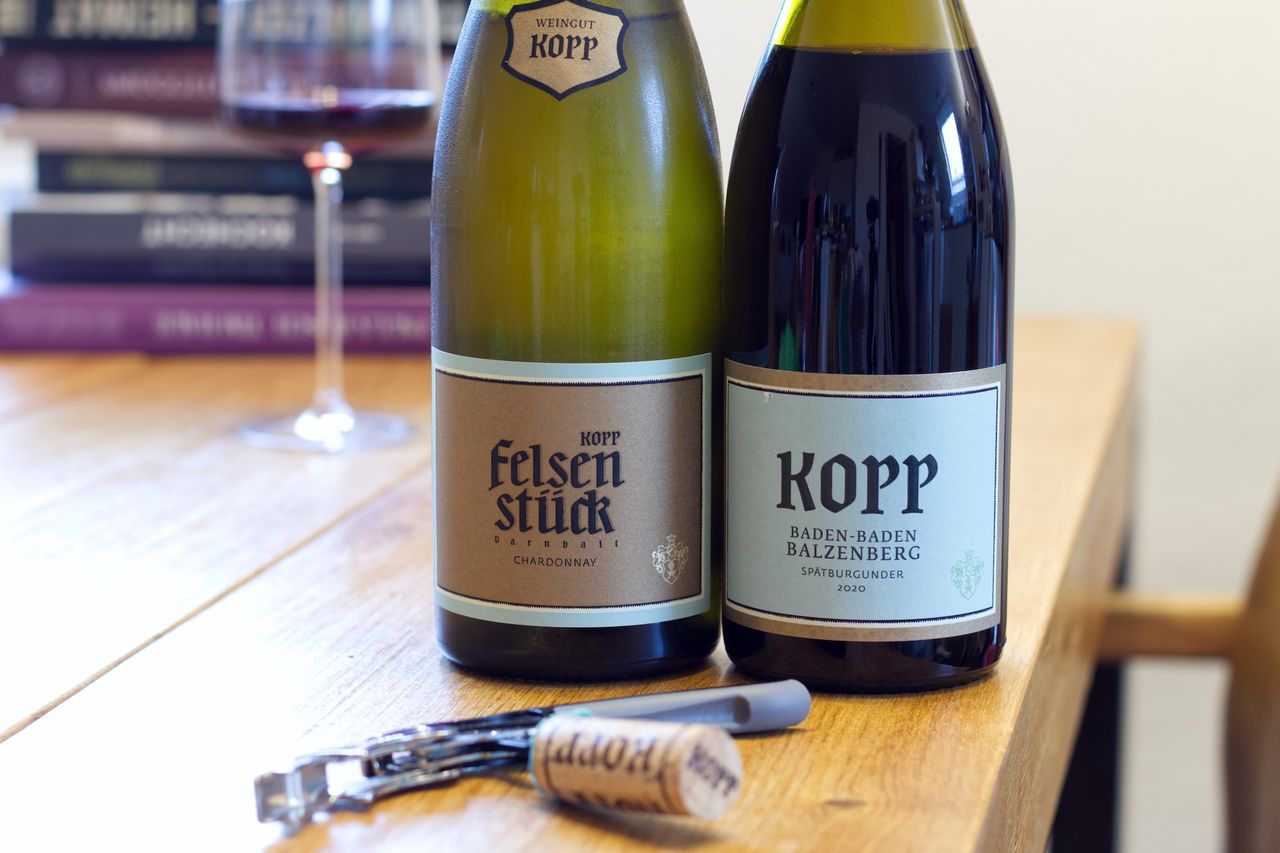Two Bottles Kopp
This week we are drinking two bottles from Weingut Kopp from Baden: a Spätburgunder Balzenberg 2020 and a Chardonnay Felsenstück 2023.

The wines from Kopp are quite similar to the Muster bottle from recently. Not the wines themselves, of course, those are completely different, but they are the kind of bottles that have been popping up for years and somehow never made it into a post. Although every time I thought, I really should. Food pairing here, wine list there, wines by the glass over there. Time and again we have drunk Kopp or Kopp has crossed our path. It went so far that right before writing this, while we were drinking two or three well-deserved shopping-break-wines in Stuttgart-Mitte, someone from the winery itself walked into the shop to drop off sample bottles. Timing basically doesn’t get any better.
It was not until 1996 that Ewald Kopp founded the winery in Baden-Baden in, it’s obvious, Baden. Baden as a wine-growing region is, if you ignore the enclaves in Taubertal and Bodensee, quite elongated, stretching from the very southwest on the border with Switzerland all the way up to the Hessian Bergstraße between Heidelberg and Bensheim. With Baden-Baden, we are now pretty much in the middle of the enormous north-south extension of the wine region, in the sub-region of Ortenau between the edge of the Black Forest and the Rhine. The then solitary hectare has since grown to over 30 hectares. In the current generation, Johannes Kopp has been running the winery since 2012. From the very beginning, the vines were cultivated organically, and since 2022 they have been certified biodynamic in their farming. The focus is on Burgundy varieties, but Riesling from a vineyard surrounded by forest is also bottled, as well as whatever else they have standing in the vineyard. The Pinot grows in the Baden-Badener Balzenberg (which I could not find on any of the site maps known to me, therefore without a link) on silt, Rotliegendem and clay slate. It is aged for 22 months in barrique and then bottled unfiltered. The Chardonnay is in the Varnhalter Klosterbergfelsen, no, I had never heard of Varnhalt until just now either, in a central parcel on loamy, sandy soils. The wine is fermented in wood and then aged with one-third new oak.
Normally we drink here either from small to large or from red to white. That doesn’t work today and we decide to start with the Chardonnay. It doesn’t hide the new oak, nor the matchstick reduction behind it. A little further behind that follows very pale yellow fruit. Pears perhaps. The acidity in the mouth is reminiscent of yogurt, then comes citrus, which you also smell after you taste it. In general, the impression of yogurt is deceptive. It is briefly lactic, soft, supple and then really grips the tongue. We are early with this bottle, which surely has a lot of time ahead of it. But it’s already really good right now. Cool, radiant and intense. I really like it a lot.
Overnight, quince joins in and somehow it now reminds me of green apples, about a week before I would want to bite into them. That’s usually too late, because Madame opposite has no such reservations and the apples are already gone by then. Often the only choice is between unripe or not at all. I’m digressing. In any case, what the wine does on the nose, the texture it suggests there, reminds me a lot of green apple. On the palate, it then becomes more pithy than on the first evening. Less lactic character, but the yogurt doesn’t disappear completely, more citrus. It’s so clear on the palate and feels even fresher than the day before. The matchstick note is gone, the wood seems better integrated now. Everything is even more focused, more expressive and even deeper. Very, very good. And certainly at the very beginning of its life.
The Pinot has already had some time in the bottle. It is spicy, reminiscent of old, seasoned firewood, smoke and dark berries. On the nose, it initially comes across much more through spice than through fruit. There is pepper and dried herbs. It somehow reminds me of cooking. Then you take a sip and the fruit comes through. Sour cherry, a lot of juiciness, also the wood and the spice, but much less than was on the nose.
Not that much changes the next day. Dry, spicy and a lot of old wood and vanilla, more pod than bean. Somehow cozy, pleasant. As with the Chardonnay, the acidity in the Pinot also kicks it up a notch on the second day. It is so juicy now with dark currants, sour cherry and elderberry. Almost a bit like a health food store juice, where you know immediately that you have something healthy in your glass. The health food store juice, that is, the wine with its alcohol not so much. I think that with its 5 years, we have hit a pretty good point in time right now. If you have a bottle of this in the cellar, you should definitely open one up, otherwise you would be missing out.